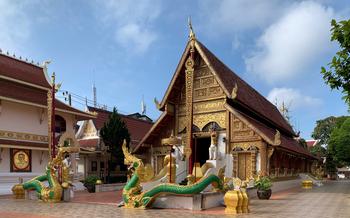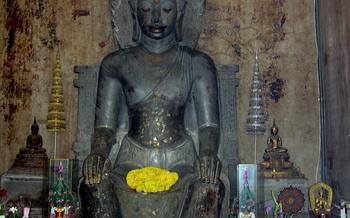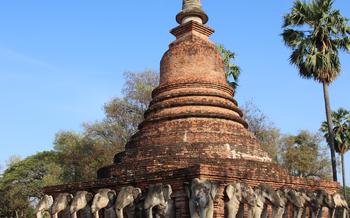
Wat Mahawanaram
- History of the Temple
- The Buddha Image
- Surrounding Scenery
- Meditation and Retreats
- Local Beliefs and Traditions
- Exploring the Temple Grounds
- Local Crafts and Handicrafts
- Learning About Buddhism
- Cultural Performances
- Pilgrimages and Festivals:
- Volunteering Opportunities
- Accommodation and Dining
- Transportation and Accessibility
- Insider Tip: Unveiling Hidden Gems and Capturing Special Moments
History of the Temple
Wat Mahawanaram, a testament to the rich and architectural mastery. Built in the 18th century, the temple's origins are deeply intertwined with the history of the region. Legends speak of a wealthy merchant who, upon witnessing a miraculous event, vowed to construct a grand temple to honor the Buddha. The temple's design, inspired by the ancient Khmer civilization, showcases intricate carvings, stupas, and a towering Buddha image, all harmoniously blending to create a sacred space that exudes tranquility and awe. Over the years, Wat Mahawanaram has undergone extensive restoration efforts, ensuring its preservation for generations to come.
An intriguing anecdote associated with the temple's history tells of a mysterious monk who arrived at Wat Mahawanaram seeking refuge. He possessed extraordinary knowledge of Buddhist teachings and meditation techniques, which he imparted to the temple's monks. Under his guidance, Wat Mahawanaram became renowned as a center of spiritual learning and meditation, attracting pilgrims and seekers from far and wide.
The Buddha Image
At the heart of Wat Mahawanaram stands an awe-inspiring Buddha statue, a testament to the temple's religious significance. Towering over the tranquil surroundings, the statue exudes an aura of serenity and reverence. The Buddha's serene countenance and graceful posture embody the essence of enlightenment and compassion. Locals and visitors alike pay homage to this sacred icon, seeking solace, guidance, and spiritual upliftment.
The statue holds deep symbolic meaning, representing the Buddha's teachings and his journey towards enlightenment. Its intricate details and elaborate embellishments showcase the artistry and devotion of the temple's creators.
Anecdote:
Legend has it that the Buddha statue at Wat Mahawanaram was once struck by lightning during a violent storm. Despite the powerful impact, the statue remained unscathed, symbolizing the unwavering strength and resilience of the Buddha's teachings. This miraculous event further solidified the statue's sacred status and drew even more devotees to the temple.
Surrounding Scenery
The serene location of Wat Mahawanaram, nestled amidst lush greenery, amplifies its spiritual allure. As you step into the temple grounds, the tranquil atmosphere envelops you, inviting you to leave your worldly worries behind. The temple is surrounded by beautifully landscaped gardens, complete with colorful flowers, serene lotus ponds, and meticulously trimmed lawns. These natural elements create a harmonious balance with the architectural wonders of the temple, enhancing its overall aesthetic appeal.
Take a moment to wander through the gardens, allowing the gentle breeze to caress your skin as you admire the vibrant flora. The lotus ponds, with their delicate blooms floating gracefully on the water's surface, offer a mesmerizing sight. Capture the beauty of these serene surroundings with your camera, creating lasting memories of your visit to Wat Mahawanaram.
One of the most captivating features of the temple grounds is the breathtaking view of the surrounding landscape. From certain vantage points, you can witness the sun casting its golden rays across the temple spires, creating a magical aura. As the day progresses, the sky transforms into a canvas of vibrant hues, painting a picturesque backdrop for the temple.
Whether you choose to sit by the lotus ponds, stroll through the gardens, or simply bask in the tranquility of the surroundings, Wat Mahawanaram offers a sanctuary for peace and contemplation. Let the serene atmosphere wash away your stress as you immerse yourself in the beauty of nature and spirituality.
Meditation and Retreats
The serene ambiance of Wat Mahawanaram makes it an ideal sanctuary for meditation and spiritual retreats. Practitioners can immerse themselves in the tranquil surroundings, conducive to self-reflection and mindfulness. The temple offers dedicated meditation spaces where visitors can find inner peace and connect with their spiritual selves. Whether seeking a short respite from daily life or a longer retreat to deepen their practice, Wat Mahawanaram provides a nurturing environment for spiritual exploration.
Anecdote:
During my visit to Wat Mahawanaram, I had the opportunity to participate in a guided meditation session led by a resident monk. As I settled into a comfortable position, the monk's soothing voice and gentle instructions guided me on a journey of inner exploration. The tranquil atmosphere of the temple and the presence of fellow practitioners created a sense of profound serenity. The experience left me feeling refreshed, rejuvenated, and deeply connected to my inner self.
Practical Information:
- Meditation sessions are typically held daily at designated times. Visitors are advised to inquire about the schedule upon arrival.
- The temple provides meditation cushions and mats for participants. However, it is recommended to bring your own if you have a preferred meditation style.
- Retreats are offered periodically throughout the year, ranging from a few days to several weeks. Visitors interested in participating in a retreat should contact the temple in advance to inquire about availability and make arrangements.
- Accommodation for retreat participants is available within the temple grounds, offering a simple and serene living environment.
Local Beliefs and Traditions
Wat Mahawanaram is a testament to the deep-rooted Buddhist traditions and practices prevalent in Thailand. Daily chants and prayers fill the air, creating an aura of spirituality that envelops the entire temple complex. The faithful gather to offer their devotions, light incense sticks, and make merit by contributing to the temple's upkeep.
During significant Buddhist holidays and festivals, the temple transforms into a vibrant hub of activity. The annual Buddha Day celebrations, held in May, showcase grand processions, colorful parades, and special ceremonies that draw thousands of devotees. The temple's ordination hall becomes the stage for sacred rituals where young men and women embark on their journey to become monks and nuns.
One particularly memorable festival is the Candle Festival, held in July. During this time, the temple's courtyards are adorned with thousands of flickering candles, creating a magical and enchanting atmosphere. Devotees carry elaborately decorated candles and participate in processions, offering light and prayers to the Buddha.
Visitors are welcome to observe these ceremonies and festivals, but it's essential to be mindful of local customs and traditions. Dress modestly, remove your shoes before entering the temple's sacred spaces, and always show respect to the monks and other devotees. By immersing yourself in these local beliefs and traditions, you'll gain a deeper understanding of Thailand's rich cultural heritage and the significance of Wat Mahawanaram as a spiritual center.
Exploring the Temple Grounds
Stroll through the temple's courtyards, where intricate walkways and serene gardens create a tranquil oasis. Discover hidden corners adorned with delicate sculptures and architectural details that whisper stories of the past. Marvel at the towering stupas, each representing a different chapter in the temple's rich history. As you wander, keep an eye out for friendly monks or local visitors who may share fascinating insights or anecdotes about the temple's significance. Embrace the opportunity to get lost in the labyrinthine paths, allowing yourself to be transported back in time as you explore the many wonders of Wat Mahawanaram.
Anecdote:
During my visit, I stumbled upon a secluded courtyard nestled amidst lush greenery. As I sat down on a nearby bench to admire the intricate carvings on the surrounding walls, a friendly monk approached me. He shared stories of the temple's history and its role in the community. I learned about the symbolism behind the various statues and stupas, and gained a deeper understanding of the Buddhist teachings that permeate every aspect of the temple's design. It was a truly enriching experience that left me with a newfound appreciation for the spiritual significance of Wat Mahawanaram.
Tips for Navigating the Temple Grounds Efficiently:
Obtain a map or guidebook from the temple office to help you navigate the extensive grounds. Wear comfortable shoes, as you will be doing a lot of walking. Be mindful of the temple's dress code and behave respectfully at all times. If you're visiting during the rainy season, bring an umbrella or raincoat to protect yourself from the elements. Take your time exploring the temple and savor the peaceful atmosphere.
Local Crafts and Handicrafts
At Wat Mahawanaram, visitors will find a vibrant community of artisans and craftsmen showcasing their skills and offering unique handmade products. These talented individuals, often from local villages, create beautiful and intricately designed crafts using traditional techniques passed down through generations. From intricate sculptures and paintings to woven textiles and delicate jewelry, there's a treasure trove of items to discover.
One artisan, a skilled woodcarver named Somchai, has been practicing his craft for over 20 years. With a deft hand, he transforms ordinary pieces of wood into intricate figurines, masks, and decorative ornaments. Visitors can watch him work, marveling at the precision and artistry that goes into each creation. Somchai's passion for his craft is evident in the intricate details and unique designs of his pieces.
Another artisan, a silversmith named Suda, specializes in creating delicate and elegant jewelry. Her intricate designs feature intricate patterns and semi-precious gemstones, each piece a true work of art. Suda's skill and attention to detail are apparent in the delicate filigree work and the way she combines different metals and stones to create harmonious and eye-catching pieces.
By purchasing these handmade crafts, visitors not only take home a unique souvenir but also support the livelihoods of these skilled artisans and contribute to the preservation of traditional Thai craftsmanship. The local market at Wat Mahawanaram is a wonderful place to find authentic and meaningful souvenirs while supporting the local community.
Learning About Buddhism
Wat Mahawanaram offers a unique opportunity to delve into the teachings and practices of Buddhism. Visitors can engage in discussions with monks and teachers who are eager to share their knowledge and insights. These interactions provide a deeper understanding of the religion's history, philosophy, and practices. Whether you're a seasoned practitioner or a curious traveler, the temple provides a welcoming environment for learning and spiritual exploration.
Anecdote:
During my visit to Wat Mahawanaram, I had the privilege of speaking with a monk named Phra Ajaan Somdet. With a warm smile and gentle demeanor, he patiently answered my questions about Buddhism, its core principles, and the significance of the temple. His explanations were clear and insightful, leaving me with a newfound appreciation for the religion's teachings.
Tips for Respectful Interactions:
- Approach monks and teachers with humility and respect.
- Be mindful of your body language and tone of voice.
- Ask thoughtful questions that demonstrate a genuine interest in learning.
- Be open to listening and receiving guidance.
- Avoid interrupting or engaging in debates.
Cultural Performances
Wat Mahawanaram is not just a place of worship and meditation; it also serves as a stage for traditional Thai cultural performances. Throughout the year, the temple organizes and hosts a variety of shows that showcase the beauty and diversity of Thai dance and music. These performances are a feast for the senses, allowing visitors to immerse themselves in the rich cultural heritage of the region.
One of the highlights of these performances is the graceful and expressive Thai classical dance. Dancers adorned in elaborate costumes, accompanied by the melodious sounds of traditional instruments, captivate audiences with their intricate movements and storytelling abilities. The performances often depict ancient legends, folktales, or scenes from the Ramayana, Thailand's national epic.
In addition to classical dance, visitors can also enjoy lively folk dances that showcase the unique traditions of different regions of Thailand. These dances are often performed to the rhythm of energetic percussions and feature colorful costumes and props. The performances are a joyous celebration of Thai culture and provide a glimpse into the country's vibrant artistic expressions.
Whether you are a passionate lover of dance or simply looking for an enriching cultural experience, the performances at Wat Mahawanaram are not to be missed. Check the temple's event calendar or inquire with the local tourism office for the schedule of upcoming performances.
Pilgrimages and Festivals:
Wat Mahawanaram holds a significant place among Buddhist pilgrims, attracting devotees from across Thailand and beyond. The temple's sacred atmosphere and stunning architecture make it an ideal destination for spiritual journeys. Throughout the year, the temple hosts several festivals and celebrations that draw large crowds of worshippers and visitors.
One of the most important festivals is the annual Visakha Bucha Day, which commemorates the birth, enlightenment, and passing of Lord Buddha. During this festival, the temple is adorned with colorful decorations, and special prayers and ceremonies are held throughout the day. Devotees offer flowers, candles, and incense to the Buddha image, and engage in meditation and chanting. The temple's serene surroundings create a perfect backdrop for spiritual reflection and contemplation.
Another popular festival is the Songkran Festival, also known as the Thai New Year. Celebrated in April, this festival is marked by water splashing and merit-making activities. At Wat Mahawanaram, visitors can participate in water processions, pour water over Buddha images for good luck, and release caged birds as a symbol of freedom and compassion. The festival exudes a joyous and vibrant atmosphere, allowing visitors to immerse themselves in Thai culture and traditions.
For those seeking a more immersive experience, Wat Mahawanaram also offers meditation retreats and ordination ceremonies. These retreats provide an opportunity to learn about Buddhist teachings, practice mindfulness, and connect with fellow practitioners. Ordination ceremonies, where individuals formally enter the Buddhist monastic order, are significant events that draw many observers and participants. Witnessing an ordination ceremony is a unique and humbling experience that offers a glimpse into the deep spiritual traditions of Thailand.
Volunteering Opportunities
Embracing Compassion through Service at Wat Mahawanaram
Beyond sightseeing and spiritual exploration, Wat Mahawanaram offers visitors the opportunity to engage in meaningful volunteer work that contributes to the upkeep and preservation of this sacred site. By lending a helping hand, travelers can immerse themselves in the temple community and make a positive impact while experiencing the essence of Buddhist compassion and generosity.
Various volunteer projects are available throughout the year, allowing visitors to choose activities that align with their interests and skills. Gardening enthusiasts can assist in maintaining the temple's lush gardens, nurturing the vibrant flora that enhances the temple's serene atmosphere. Those with a knack for cleaning and organization can help with general upkeep tasks, ensuring that the temple remains pristine for visitors and devotees alike.
For those seeking a more interactive experience, teaching opportunities are available at the temple's school, where volunteers can share their knowledge and skills with young monks and students. Whether it's teaching English, math, or art, volunteers can make a lasting impact on the education and development of these young minds.
Anecdote: A Rewarding Volunteer Experience
During my time at Wat Mahawanaram, I had the privilege of volunteering in the temple's garden, where I worked alongside a group of dedicated locals and fellow travelers. Together, we tended to the flower beds, pruned the trees, and watered the plants, creating a vibrant oasis that welcomed visitors with its beauty and tranquility.
As we worked, I felt a sense of deep connection with the temple and its community. The monks and locals were incredibly welcoming and grateful for our assistance, and we shared many smiles and conversations as we labored together. It was a humbling experience to be part of something larger than myself and to contribute to the upkeep of this sacred space.
Practical Information
To volunteer at Wat Mahawanaram, simply contact the temple directly or inquire at the visitor center. The temple welcomes volunteers of all ages and backgrounds, and no prior experience is necessary. It's important to note that volunteering is a commitment, and visitors should be prepared to dedicate at least a few hours of their time to the project.
Whether you're a seasoned volunteer or simply looking for a meaningful way to give back during your travels, volunteering at Wat Mahawanaram is an enriching experience that will leave a lasting impression on your heart and soul.
Accommodation and Dining
For a truly immersive experience, consider staying in one of the many nearby guesthouses or homestays. These accommodations offer a chance to connect with the local community and experience traditional Thai hospitality. Homestays, in particular, provide a unique opportunity to learn about daily life and customs in Ubon Ratchathani.
When it comes to dining, there are plenty of local restaurants and eateries within walking distance of Wat Mahawanaram. Indulge in delicious Thai cuisine, from fragrant curries to fresh seafood dishes. For a taste of local favorites, try the grilled chicken with sticky rice or the spicy papaya salad. Don't miss the chance to sample the sweet and sticky mango sticky rice, a popular Thai dessert.
Anecdote:
During my stay in Ubon Ratchathani, I had the pleasure of dining at a local restaurant near the temple. The atmosphere was warm and inviting, with friendly staff and a menu filled with mouthwatering dishes. I opted for the classic pad thai, which arrived piping hot and bursting with flavor. The balance of sweet, sour, and savory was simply divine. As I savored each bite, I couldn't help but feel grateful for the opportunity to experience such authentic Thai cuisine.
Transportation and Accessibility
Reaching Wat Mahawanaram is a breeze, with various transportation options available. Hop on a local bus or songthaew (shared taxi) from the city center, or rent a bicycle and pedal your way through the charming streets of Ubon Ratchathani. For a more personalized experience, hire a tuk-tuk or taxi, allowing you to set your own pace and explore nearby attractions.
Upon arrival, you'll be greeted by a spacious parking area, accommodating both cars and tour buses. For those with limited mobility, the temple is wheelchair accessible, ensuring a hassle-free visit for all.
My most memorable journey to the temple was during the annual rocket festival. As I stepped out of the songthaew, the vibrant energy of the festival washed over me. Locals in colorful attire filled the streets, and the air buzzed with excitement. The procession of elaborately decorated rockets was a sight to behold, and I couldn't help but be swept up in the joyous atmosphere.
Whether you choose to arrive by public transport, private vehicle, or bicycle, the journey to Wat Mahawanaram is sure to be a memorable experience. Embrace the local culture, soak in the sights and sounds of Ubon Ratchathani, and let the temple's serene atmosphere wash away your worries.
Insider Tip: Unveiling Hidden Gems and Capturing Special Moments
Beyond the main attractions, Wat Mahawanaram holds secret spots waiting to be discovered. Explore the temple's serene gardens and courtyards to find hidden corners adorned with intricate sculptures and peaceful lotus ponds. These tranquil havens offer a respite from the crowds and an opportunity to connect with the temple's spiritual essence.
For an unforgettable experience, plan your visit during the early morning hours or just before sunset. As the sun casts a golden glow over the temple grounds, the atmosphere transforms into a magical spectacle. Capture the ethereal beauty of the Buddha image bathed in soft light, and relish the tranquility of the surroundings.
To make the most of your visit, engage with the friendly monks or local visitors. They can share fascinating stories about the temple's history, traditions, and cultural significance. These interactions will deepen your understanding and appreciation of Wat Mahawanaram.
Whether you're seeking solitude, inspiration, or a unique photographic opportunity, Wat Mahawanaram offers endless possibilities. Embrace the temple's enchanting atmosphere, discover its hidden gems, and create lasting memories that will stay with you long after your visit.





